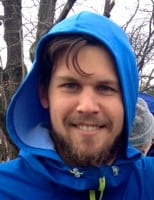Andy Symonds is a seriously good runner, but he’s not so serious about it. Sure, he’s finished second (2012) and fourth (2016) at the talent-laden Transvulcania Ultramarathon, and won this year’s Lavaredo Ultra Trail, but the Brit living in France doesn’t plan to quit his day job anytime soon. For Symonds, running is much more a hobby—an enjoyable activity that he hopes will keep him engaged for a lifetime—than a profession. In the following interview, Symonds offers a refreshingly balanced perspective about running and life that’s worth ruminating on.
Put your feet up, listen to this audio preview, and then enjoy reading Andy’s lighthearted and insightful banter below.
iRunFar: Let’s get right into it and talk about the ‘pole technique’ video you posted earlier this year.
Andy Symonds: [laughs] We had quite a lot of fun making that. I want to make a second edition of that [laughs].
iRunFar: I liked it because I think the video says so much about who you are. Would you agree?
Symonds: It tells you what I think about poles [laughs]. And Brexit, maybe. And Europeans who run with poles. That’s kind of the way I try to see the sport, I suppose—mix it up with a bit of humor. It’s just a hobby at the end of the day, you know? So use it to have a bit of fun.
iRunFar: You try not to take it too seriously.
Symonds: Yeah, totally. That’s kind of how I’ve been brought up in it probably as well. My dad wrote a book when I was like eight, nine [years old]. He ran over all the mountains in Great Britain and Northern Ireland. Running has always been what he’s been doing. He was pretty serious, at a good level. He competed for Britain and at the international level. But I never saw it as mega-serious, you know? It’s always been, We do it because we enjoy doing it, rather than we have to, sort of thing, or because you want to win a race.
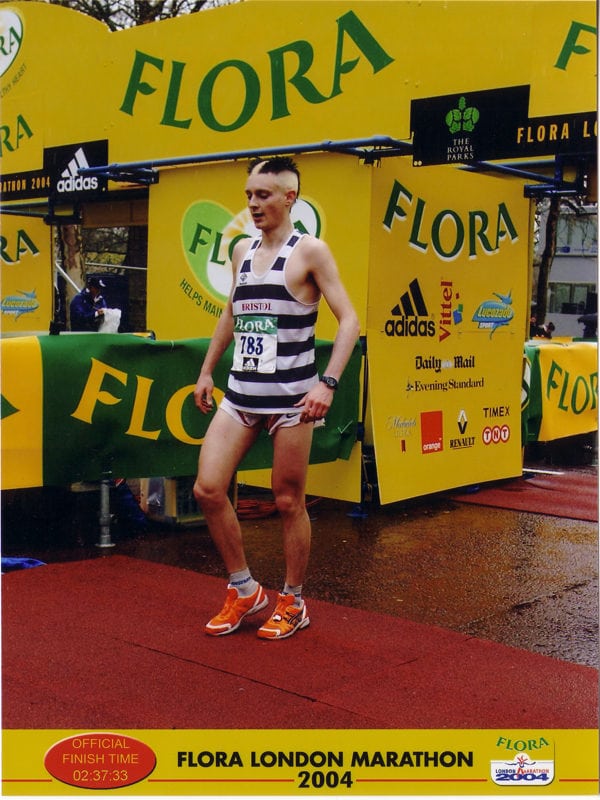
A colorful Andy Symonds finishes the 2004 London Marathon. All photos courtesy of Andy Symonds unless otherwise noted.
iRunFar: Your dad, then, he was a badass runner.
Symonds: He was really good, yeah. He was one of the best fell runners in the U.K. at his time, in the ’80s. He went to some of the first world championships—that’s when they first started doing the World Mountain Running Championships. He went a couple of times to that. He was second at the Pikes Peak Marathon one year too.
iRunFar: He was the first person to run up all the mountains in the U.K. and Northern Ireland. How many are there?
Symonds: Yeah. At the time—they’ve re-measured some of them—but at the time it was 303 in the whole of England, Scotland, Wales, and Ireland. He basically took three months and he ran them continuously and ran between them. In Scotland, there’s not a lot of distance between them, but to get from Scotland to England, you have to run a long way on paths and roads to get all the way down to the couple of mountains there are in England. The definition of a mountain there is above 3,000 feet—that’s a decent mountain in the U.K. He did over 2,000 miles I think.

Andy’s father, Hugh Symonds, wrote a book about his epic mountain run.
iRunFar: That’s not normal, by any means, but at nine years old you might have thought so?
Symonds: I never questioned that kind of thing. It was pretty cool because we had a term off school and my parents asked if we could go out of school to follow him. My dad was a teacher and so was my mum. The school let him have a term off to do it because he had worked there long enough—he did it for a charitable cause and that.
Basically, mum taught us in the camper van. Rather than doing maths and history and stuff, we did the clouds and the flowers and the birds [laughs] for a term, so it was quite cool. We did things like the temperature, following the weather, the more natural stuff I guess. We were in a camper van, a big camper van, for three months.
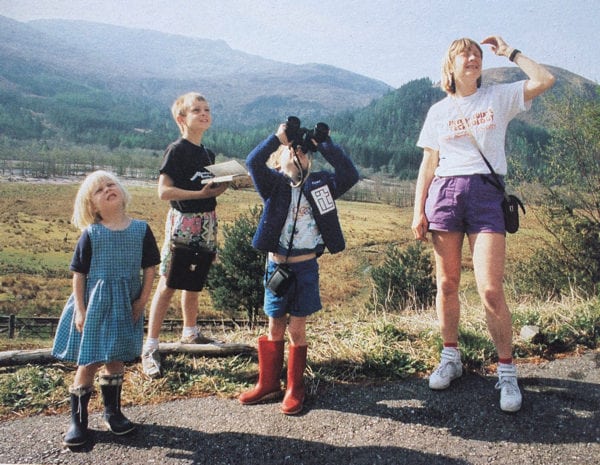
Andy’s mother teaching her children during their three-month trip.
iRunFar: You thought it was great?
Symonds: Oh yeah. I actually navigated the whole trip—I did the map reading for my mum in the van, so I’d sit up front. It’s quite amazing to think about because now my son is seven and my daughter is five. So at eight or nine, I was navigating this van for three months. Apparently I never got it wrong, so I guess I learned how to read a map at nine [laughs]—much more important than doing history and geography lessons.
iRunFar: Real-world application. I don’t know how inspired nine year olds become…
Symonds: No, I don’t have any recollection of thinking, Yeah, that’s great I want to do that. It was just kind of normal and natural and seemed like pretty good fun, and that was about it [laughs].
iRunFar: Your dad must have gotten some press.
Symonds: Yeah, on the national scale even. He got the Runner’s World Runner of the Year in Britain for that. It’s a long time ago now, 25 years ago.
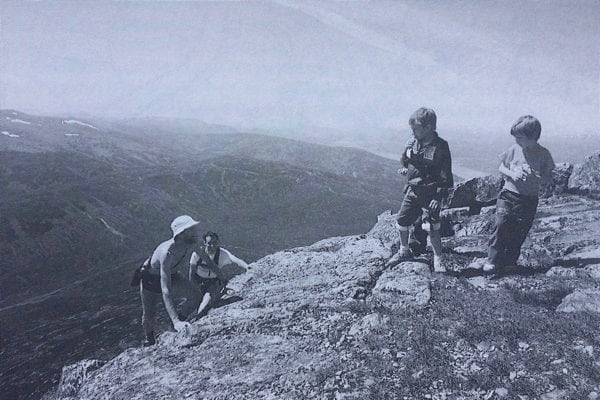
Andy’s father summiting one of the 303 peaks.
iRunFar: Is that something you reflect on and think, I’d like my own kids to have an experience like that?
Symonds: It’s scary now because my kids are nearly as old as I was when he did that. So I need to get planning something. I did have—I wanted to do it five years ago, I wanted to run up all the highest mountains in Europe and maybe bike between them. I’ve studied and have a list of all the peaks you have to do, and you need probably six months to do it. There’s a guy just doing it now and I think he’s about three quarters of the way through. I do fancy doing something like that. I can’t imagine doing it right now but maybe in a few years time.
iRunFar: You have two years to figure it out because then your son will be nine.
Symonds: [laughs] Exactly. My dad always reckons that that trip took the edge out of his legs a little bit, took the speed out of his legs—just running so far and so slowly for so many days. I’ll give it a few more years.
iRunFar: But your dad took a don’t-take-it-too-seriously attitude.
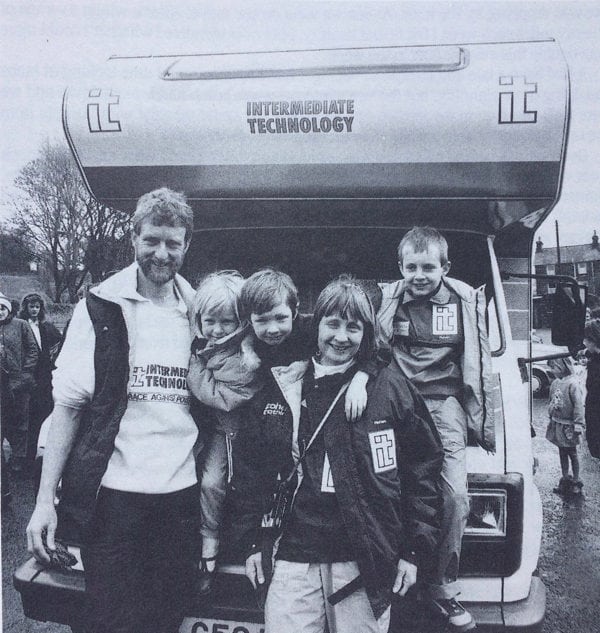
Andy’s family and their camper van.
Symonds: Yeah, and it’s the same for me completely now. Everything I do, including the [IAU Trail] World Championships. You have to be semi-serious about it if you want to do well, but at the end of the day it’s just a hobby really, isn’t it? You’re just doing it for fun, I suppose.
That’s the way I’ve always felt it in the family: nothing serious, just enjoying it. It’s part of the holidays and stuff. For me, it’s part of what we do, we spend time outside, and then I just go and do a bit more. I’ll go up an extra hill kind of thing [laughs]. I don’t see it as a really mega-serious thing I suppose, or as an obligation—not an obligation. I guess if I’m not feeling up for it, or super motivated after big races, you want to sit on your ass kind of thing. I don’t force it. That’s been a bit of the case since this summer and now I’m getting back into it.
iRunFar: Do you think that’s how you are generally, about other things in your life—you don’t take it too seriously?
Symonds: Oh, definitely. Yeah, just try to enjoy life. At the end of the day, you only get one shot, I suppose. There’s no point in spending your whole life getting worried and annoyed. Not everyone sees it that way. It’s sad, really. Maybe they regret it just before they die, but hey [laughs].
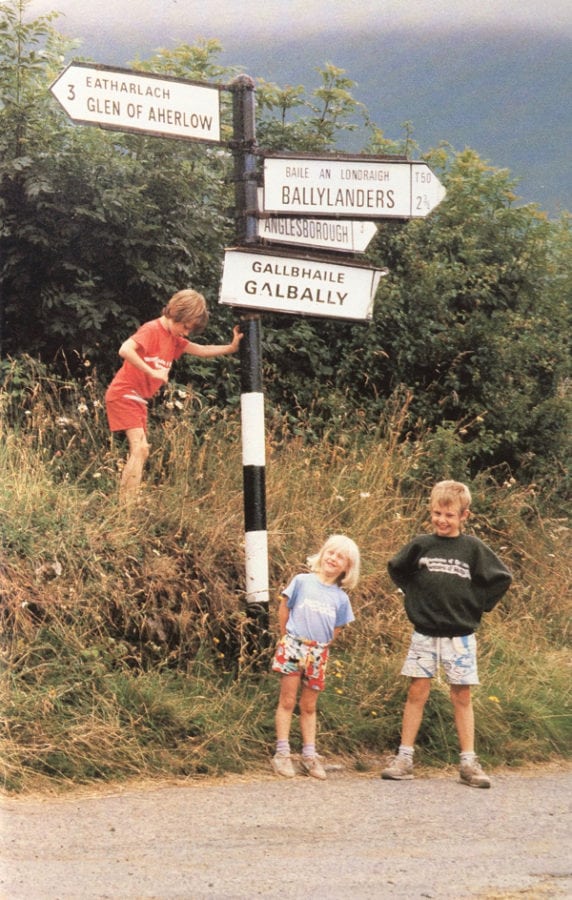
Andy and his siblings, circa 1990.
iRunFar: How does that mentality fit in with your work life? Or I guess that’s just sort of French, isn’t it?
Symonds: Yeah, well I have a pretty serious job. I’m an engineer in charge of buying wind turbines and contracts and stuff. It’s an office job, so I’m often in meetings, often at the computer. I’ll be in London this week, up in Paris a little bit. So I do get around and it’s a proper job. I take it seriously [laughs], and I try to do a good job—I enjoy working in renewables. But at the same time, I feel like I have a good balance because my company lets me work 80%, so I’m not 100% time. They kind of do a little sponsorship deal for me. I don’t work on Wednesdays. That, for me, really allows me to mix it up well with the family and training, to spend a bit more time running and with the family. I can also run at lunchtime—it’s a bit flat but I can get out. For me, it’s a pretty good balance. I’m happy at the moment. I’d have a difficult time jumping into a full-time job.
It’s a dangerous thing when people work too much. When they get toward the end of their career, they burn out and think, What do I do now? That’s really dangerous, I think. You get to retirement and you’re like, What do I do now? With my parents I don’t see that at all. They retired early, about five years ago, just before they were 60 [years old], and they’ve spent more time, I think, on their bike seats than they have at home. They’re always off doing six-month trips on their bicycle, that kind of thing. They have no problem filling their time [laughs].
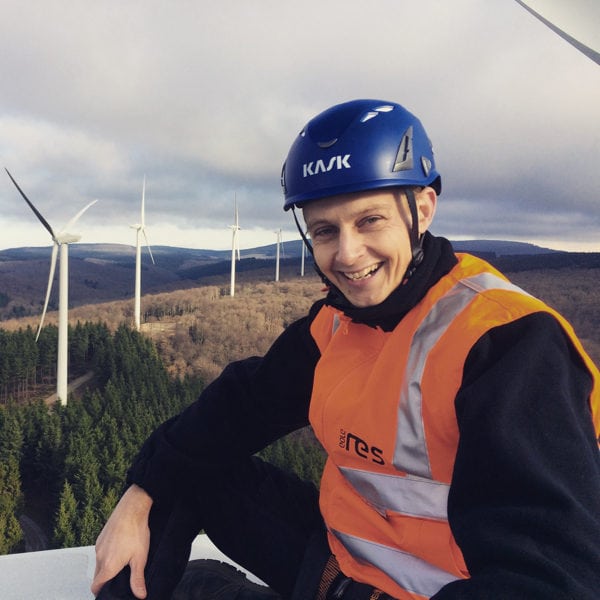
On a job site at the top of a wind turbine.
iRunFar: Even now, they’re staying active like that?
Symonds: They’re 63, yeah, and they’ve actually been staying with me in France for a month or so. There are a bunch of local races here. My mum often does them. She’s always the first [finisher] over 60 [laughs], and one of the best women as well usually. It’s amazing. She’s been out just now for about two hours. She went out an hour before me, then I went out for an hour [run]—she’s still running [laughs].
iRunFar: And your dad still runs as well?
Symonds: A bit. Yeah, he was out with me the other day before we talked. He was just out with me today but cut back after a few miles. He still runs a bit but does a lot more cycling. He tries but his legs are cramping up a bit sometimes—more than he’s used to.
iRunFar: So it’s right to say that your love of the outdoors and your don’t-take-it-too-seriously attitude was inherited from you dad?
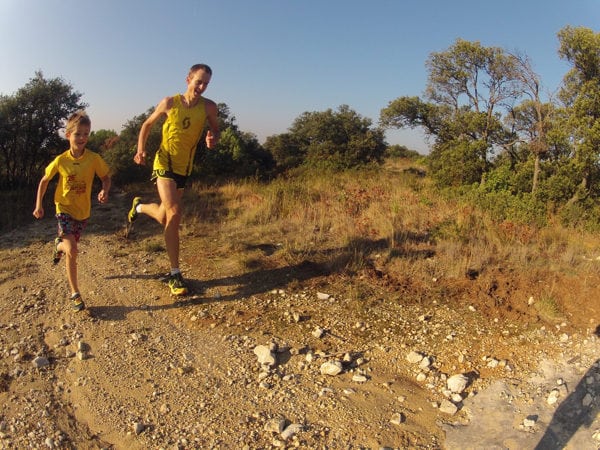
Andy and his son. Running clearly runs in the Symonds family.
Symonds: I’d say that’s right, yeah. I think a lot of how you are is how you’re brought up, isn’t it? We were never forced to do anything at all. So how I got into running—I wouldn’t say it was my parents that put me into running at all actually. I was brought up with it being a normal thing to do because my dad was doing it a lot. My mum didn’t take it up until quite late actually. So my dad was doing it a lot when I was nine, 10.
Then I started running at school at like 10, 11, 12 [years old]. I started joining in on cross country—three or four miles in the mud, along the river. Then at about 14, 15, I started representing the region in the U.K. and England. At 15 I tried the trial for the England team for mountain running. I got into that team. So I ran for England quite a few times from 15, 16, up to 18, and into my early twenties. I did the World Mountain Running Championships a couple of times. One year the world champs were in Alaska, which I did as a senior—I was 21 or 22. I did the mountain running quite a lot. So I started off doing the mountain running—I did cross country and then mountain running. Well, what they call mountain running. I actually think mountain running is a bit shit [laughs].
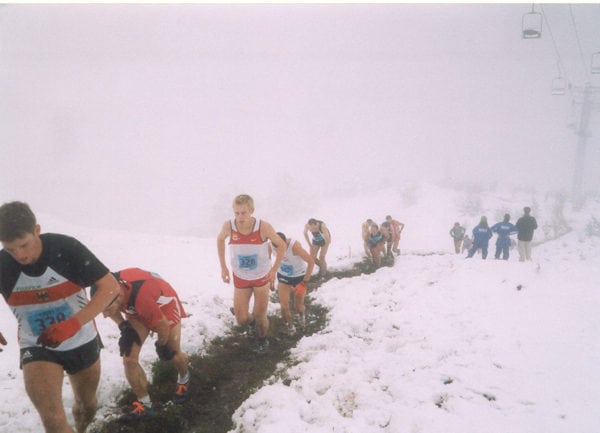
The 2003 World Mountain Running Championships in Alaska.
iRunFar: Compared to fell running or what?
Symonds: Well, no, I did fell running, and fell running is good. But what’s not good is—you know the World Mountain Running Association (WMRA) series? For me, that’s basically what cross country should be because they’ve turned [mountain running] into lap courses. It’s great fun and good to watch, but it’s usually three laps of a 5k loop up a little hill. It’s often in cities or near cities. It’s not really mountain running. The uphill-only years are, but the up-and-down ones aren’t. If it’s real mountain running, you’d run up and down the mountain, not around the park three times. You know? The ones I’ve done in Malaysia and even Alaska—it was kind of mountainous but it was three laps around a ski resort. It’s not really mountain running. So by then—I did a couple of marathons.
iRunFar: How’d you do on the marathons?
Symonds: I never did anything decent. I did 2:36 but I wanted to do 2:25 or something. My brother not so long ago did a 2:20. He had a go at Commonwealth and ran 2:20. My younger brother, he runs a lot.
iRunFar: Is he into the sort of stuff you’re into now?
Symonds: He’s on and off. He’s a medic. Some times he works far too hard to train long term. He’s had years—he had a year out once and just did running. He managed to get fourth in the World Mountain Running Championships. He had a really, really good year. But he can go from that to not doing much. When he trains, he trains hard, like when he did his 2:20 marathon. He was even a bit disappointed by that because you need to do 2:19 to qualify for the Scottish team. I have no desire to go back to the road marathon though.
iRunFar: When was your first marathon?
Symonds: So I went to the University of Bristol and just on the side—that’s where I met Tom Owens. You know Tom, yeah? I met him at Bristol and we both decided to do the London Marathon so we did some training together. That was literally when he started running. He was playing football until then—he was a good football player.
iRunFar: When you say football, that’s soccer, for the American audience.
Symonds: [laughs] Yeah, sorry. Then I said that I wanted to do a mountain race, and he came and we did Snowdon and he finished right behind me on not a lot of training. So he got pretty good quite quickly. Then I said, “Oh let’s go try Skyrunning, that looks like quite a good bit of fun.” So we went for a few weekends, we flew to Italy, and did some nice Sky races and came top few or top five in them. That’s when I stopped doing the WMRA mountain running and started doing Skyrunning. I thought, This is basically what mountain running should be—running up and down mountains. So I got into that then.

Andy (#9) and Tom (far right) taking cross country quite seriously.
iRunFar: I think we can put on the record that you’re responsible for Tom Owens’s running career.
Symonds: Yeah [laughs], that’s true. He owes me a cut of all his race winnings. I can send you some funny photos of him at university. I’ll tell you my whole life story now [laughs].
I met Carole, my wife, at university—she was doing an exchange. I had an exchange in France for a year too. When that finished we worked for a few months to make enough money—a couple thousand or something—not much money, but enough to go off traveling for a year. We went to Chile, we cycled the length of Chile, Carole and I, for six months. All the way down Chile because it’s obviously a nice shape to cycle down—you can’t really go left or right, you just have to go straight on [laughs]. Then at the end of that, Tom decided to go out there as well and we did the Santiago Marathon together. Then I got injured because I hadn’t done any running, I had done six months of cycling—anyway. Then we lived in New Zealand for a year. Then after a year [there]—basically, when we were in New Zealand, Carole and I were looking for jobs either in France or the U.K., and we applied for jobs in both. I ended up getting one in Scotland, so we moved to Scotland and lived there for five years. I did fell running again and more Skyrunning.
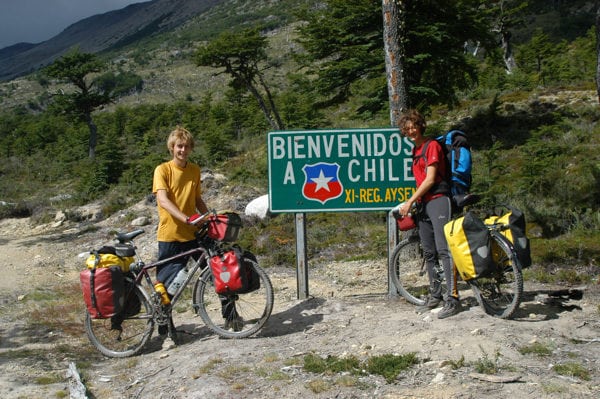
Andy and Carole bike Chile.
Then, we wanted to leave Scotland because it was raining the whole time [laughs]. So I looked for a job and found a job with this company I work for at the moment in renewable-energy systems in the south of France. So quite a big climate change [from Scotland] but that’s what we were looking for. I live in a really cool place. The sun is always shinning here and there are so many trails. It’s amazing. It was a little bit of a gamble because we didn’t know the area at all. We were looking for something near mountains—or at least medium mountains—with some sun. So I found this job in Avignon and it looked pretty good. I looked on the map and it looked pretty good [laughs]. Where we live now is a little village in a mountain range just east of Avignon. Where we ended up is amazing. As a result most of my family comes here for holidays. At the moment there are maybe 20 people [laughs].

Tom (left) and Andy after the 2005 Santiago Marathon.
iRunFar: At your house?
Symonds: Yeah, my parents, my brother and sister, their families, and some friends, my dad’s brother—loads of people. That’s quite hard to manage because it’s like a party atmosphere the whole time—the wine is opening every five minutes [laughs]. You have to watch that when it goes on for a few weeks.
iRunFar: So you really lucked out with your job and where it took you.
Symonds: Yeah, I go out the door and there are trails everywhere. For trail running, mountain biking, and even road biking, it’s absolutely—I honestly think it’s very hard to beat anywhere in the world that I’ve been. We don’t have any altitude, that’s the only problem.
So when we moved here, that’s when I started doing trail running. The French are like—trail running doesn’t really exist in the U.K., in England. You have fell running, you have trail running, but it’s not on the same scale as in France. In France it’s really big. It’s a different story basically. They’ve got loads of magazines on the shelves. In the U.K. you don’t really have that. So I started doing that and got into that and got longer and longer, gradually doing longer stuff.
iRunFar: Transvulcania, in 2012, was your first ultra then?
Symonds: I think it probably was, yeah. I’m not sure I had done anything longer than before that. I thought that was really long, but if I did that tomorrow I think it’s quite sort. Your perception evolves a little bit. I had quite good years in 2011 and 2012 but then my leg started going funny, basically, at the beginning of 2013.
iRunFar: I think that second-place finish at Transvulcania sort of put you on the map. And then it was like, where did Andy Symonds go?
Symonds: Yeah. At the time I was thinking—I was happy with the result at Transvulcania, but at the same time when you’re a minute and a half from winning, you think, Ah! I couldn’t have gone any faster that day, I know I couldn’t, but still. At the time—I had raced a couple of weeks before and I thought maybe I shouldn’t have done that and I had all these questions. I had a lot of pretty good results that year, but for me, I never thought that this was me at 100%, this was me on the way to getting better. I was always optimistic that things would get better rather than worse.
At the very beginning of 2013—I had a bit of time out at the end of 2012, like you would after a big year—I started getting back into it and as soon as I started running again, I had a weird problem with my right leg that gradually got worse basically. It would kind of cramp up or feel a bit heavy, a bit stiff, in the right quad. It would feel tight. Originally it would only start after an hour’s running, then it would be 40 minutes, then half an hour, then it got to the stage where it was basically all the time that I would have this in my right leg. It was originally only while running, and then it got to biking—and then pretty much all the time, walking around the house and things. It’s basically been like that ever since. It’s stagnated now, it’s plateaued off—it’s just a weird leg the whole time. It’s a bit better some times. It’s very rare that I take steps without my right leg feeling kind of strange.
I spent basically the whole of 2013 and 2014 going and seeing hundreds of doctors and surgeons and having millions of tests. No one ever found out what the crack is. They thought maybe—maybe a blood-flow issue, maybe a nerve somewhere. I had a couple of cortisone injections in the back even, they thought it was a possibly a problem with two discs squashing the nerve. But every test I’ve ever done has shown a normal situation. The back actually looks okay. The nerve function tests were fine. The blood flow is fine. Even the treadmill tests, when they take blood-pressure tests in your muscles and feet, were normal. No one has ever found anything wrong with me. I’ve had MRIs pretty much of my whole body [laughs]. They’ve not found anything wrong. But every time—even if I go for a little run or a bike ride with the kids—my right leg feels weird. It kind of takes the edge slightly off me. It doesn’t stop me racing, obviously, but it slightly takes the edge off my confidence in the right leg, I guess. It’s definitely slightly affected my downhill running—I don’t feel like I’m throwing myself downhill any more quite like I could before. It doesn’t feel like I quite have control. It’s a bit less in ultras because you don’t go quite so fast downhill as you do on the short ones. After a year or two of seeing doctors and sitting in waiting rooms, I kind of gave that up.
iRunFar: That must have been frustrating.
Symonds: It’s really annoying, isn’t it? I mean, what can you do? It was really pretty frustrating. I had months without running, and then I realized not running didn’t make it better so I thought I’d be a bit saner if I could go for a run. So I started running again and just kind of run through it now. I’ve taken the attitude, maybe one day it will go away. If it does, that would be amazing. If it doesn’t, I’ll just have to live with it.
That’s why I pretty much didn’t race at all for 2013 and 2014. At the end of 2014 I tried a few races, then in 2015 I tried to get back into it again. I thought I’d try and start doing some long stuff again. That was maybe mid-2015. So, 2016 was my first year running all year and doing a proper race season again. I’m just going to keep going like that now and basically ignore it and cross my fingers it will go one day. It’s a bit weird. It’s difficult to explain because it’s not painful. Every time I lift my right leg up it’s just a little bit more difficult than it is to lift my left leg up. There’s not much more to it.
iRunFar: It sounds like there’s some… resistance in your right leg or something.
Symonds: Yeah, it’s either resistance or the muscle just isn’t quite functioning right—it feels like the muscle is nearly cramping, tense when it shouldn’t be tense. For me, it does feel like a nerve problem somewhere sending the wrong signals—something minor making it do something not quite right. I’ve done leg strength tests and it’s pretty much the same [as the left], so it’s not strength.
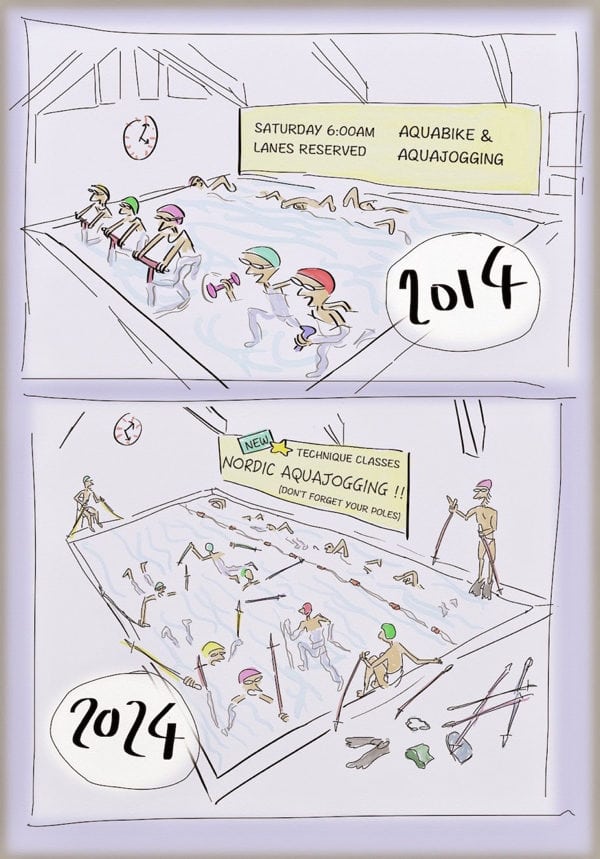
Andy shows off his sarcasm and artistic abilities with this sketch.
iRunFar: Maybe it’s better to run ultras with that problem?
Symonds: Right, that’s what I figured out—because you’re doing an ultra you can go slower, you don’t need to throw yourself downhill so fast, so you don’t need that control. Also because you’re doing an ultras, you get into such a state of leg pain by the end that it doesn’t really matter [laughs], there’s probably something worse. I’m probably not as good now at a 10k fell race, but it probably doesn’t make much difference in an ultra.
iRunFar: I guess we’ll keep seeing you at the ultras then.
Symonds: Yeah, I don’t have anything definitive. I kind of need to tick off the 100-mile distance, which I messed up this year [laughs]. I definitely want to do a 100 miler next year and it’s quite likely to be UTMB because I don’t like sitting on a failure. I’ll probably go back to that. I want to do everything but you can’t [laughs]. You have to be patient and choose wisely, which is difficult.
iRunFar: Right, you dropped from UTMB this year at 120k or so. Tell me about that race.
Symonds: I don’t know. I thought I had a pretty good chance, to be honest. Then just the last week or two before it, I wasn’t feeling fresh. And on the day, I knew I wasn’t feeling fresh and good. I don’t really know 100% why. I probably just overdid it in the weeks—well, probably the month—leading up to it. I kind of kept going with the training and I should have eased up on it a bit after the Buff [Epic Trail]—I carried on training pretty hard and should have tried to freshen up a bit earlier.

Andy dropped from the 2016 UTMB, his first 100-mile attempt. Photo: SCOTT Running
It’s tricky because you’re balancing—you know the good, long runs are pretty important, or helpful, but one too many can be killer [laughs].
iRunFar: You raced a lot this year. UTMB was your fifth ultra?
Symonds: Uh, what did I do…
iRunFar: Well Transgrancanaria was your first ultra this year. You were fifth there. Then it was Transvulcania and you were fourth.
Symonds: Yeah that’s right, isn’t it. Okay, yeah. Then there was Lavaredo [Ultra Trail], then Buff [Epic Trail], then UTMB. [Author’s note: Symonds won the Lavaredo Ultra Trail and finished second at the Buff Epic Trail.]
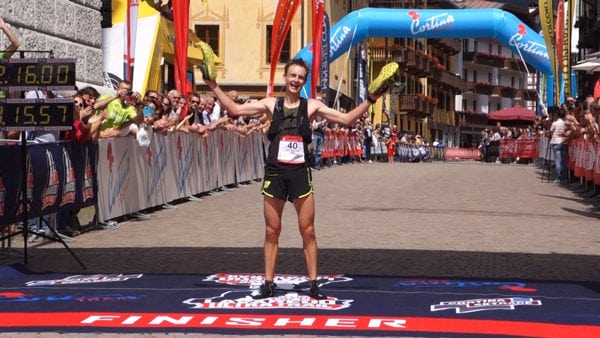
Your 2016 Lavaredo Ultra Trail winner, Andy Symonds.
iRunFar: Were you cramming before UTMB because you were worried about the 100-mile distance, you were intimidated?
Symonds: Well partly I was just feeling quite good. When I did Buff, I really held back, I didn’t do it 100%. I didn’t try to hang with Luis Alberto [Hernando]—I thought, There’s no point, he’ll probably beat me anyway. I could either finish—if I finish 15 minutes behind him, it’s not better than 30 minutes behind him, so I might as well finish 30 minutes behind him. So I did that. I actually felt pretty good, which is probably why I kept the training going high.
iRunFar: Then you came into UTMB flat.
Symonds: Yeah, I just couldn’t freshen up. On the day, I felt pretty rubbish from the beginning—from the first climb I knew it was going to be a hard day. But some times you can go through a patch where you think it’ll be a hard day then an hour later it gets better. It never did get better. I pulled through and people started bonking pretty early. But it wasn’t much later that I completely blew up.
I had never blown that badly before, I don’t think, because normally I think—you know, you just push it through. I would have liked to finish, even if it was 10th or 20th, but there was no way I was finishing. I was totally cooked. Big time [laughs]. I couldn’t do anything.
iRunFar: But your season isn’t over.
Symonds: It’s a bit silly, isn’t it [laughs]? It’s two months between UTMB and the IAU Trail World Champs. I’ve adopted the complete opposite approach and haven’t done any long runs. I’m just trying to freshen up, take it easy, and do some speedwork, get light on my feet. I haven’t done anything over about an hour-and-a-half since UTMB. I might pay for it [laughs], but I don’t know, we’ll see. Racing is nice because you can travel and see some more of the world, and if you combine it with holidays and the family, like I often do, it works well because you have a limited amount of holiday. That’s always in the back of my mind: where’s it at? Is it in a boring city and flat? Then I probably won’t go [laughs]. If it looks like it’s somewhere beautiful with not many people, then I will go.
iRunFar: That’s what draws you to places and races, the scenery and what you can do outside?
Symonds: Yeah, and exploring new places as well. There’s a lot of the world to see. But when it’s October and you’ve done five or six ultras already, you’re pretty keen to just put your feet up and have a beer [laughs].
iRunFar: The trail world championships has you off the couch and setting the beer down?
Symonds: [laughs] Well I’ve been doing quite a bit of both, to be honest. But it’s a big race. Once my legs started feeling better after UTMB, the motivation starts to come back naturally. If I get out on my mountain bike, it’s usually a good sign. It’s something extra that I do. It’s a sign that I’m getting a bit of motivation back, I suppose. You can’t force it.
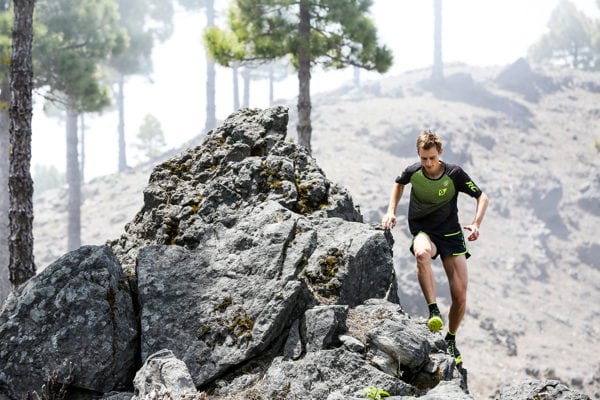
On the island of La Palma in May of 2016. Photo: SCOTT Running/Ian Corless
